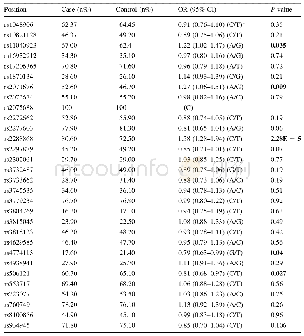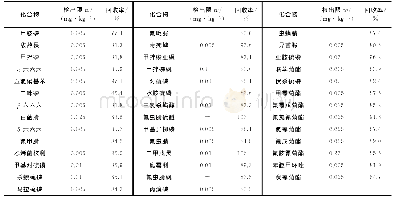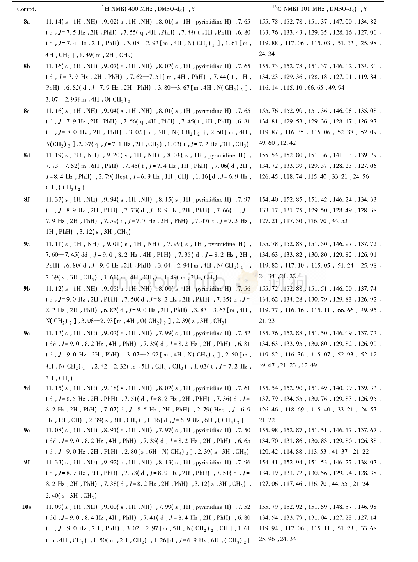《Table 1 Selected measurements (in mm) of 41HIII 0404and 41HIII 0415》
 提示:宽带有限、当前游客访问压缩模式
提示:宽带有限、当前游客访问压缩模式
本系列图表出处文件名:随高清版一同展现
《"Morphological and Phylogenetic Study Based on New Materials of Anchiornis huxleyi(Dinosauria, Theropoda) from Jianchang, Western Liaoning, China"》
Notes:*,the estimated complete length of a partial element;abbreviations:L,left;R,right.
The skulls in new specimens are triangular in lateral view and have a relatively blunt snout,like LPM-B00169(Hu et al.,2009).The posterior part of skull is unidentifiable in the new specimens(Fig.4a).The length of the skull in 41HIII 0415 is 51.4 mm(Table 1).The maxillary process of the premaxilla extends posteriorly so that the premaxilla does not compose the posterior border of the external naris,different from some dromaeosaurids like Sinornithosaurus(Xu et al.,1999)(Fig.4b) .Anchiornis bears four sub-equal premaxillary teeth which are closely packed and are not strongly bent posteriorly.There is no serration on the anterior and posterior carine,as seen in some dromaeosaurids and troodontids like Sinornithosaurus(Xu et al.,1999;Liu Jinyuan et al.,2004),Xixiasaurus(Lüet al.,2010)and Microraptor(Xu et al.,2000,2003).As seen in LPM-B00169,the antorbital fossa contains promaxillary fenestra,maxillary fenestra and antorbital fenestra,similar to most dromaeosaurids and troodontids like Sinornithosaurus(Xu et al.,1999;LiuJinyuan et al.,2004),Sinornithoides(Currie and Dong,2001)and Aurornis(Pascal et al.,2013a)but different from Bambiraptor(Burnham et al.,2000)and Shanag(Turner et al.,2007a)(Fig.4c) .The number of maxillary teeth is close to ten,which is less than some dromaeosaurids and troodontids such as Xixiasaurus(Lüet al.,2010),Tsaagan mangas(Norell et al.,2006),Austroraptor(Novas et al.,2008),Sinornithoides(Russell and Dong,1993),Sinusonasus(Xu Xing and Wang Xiaolin,2004b),Jinfengopteryx(Ji Qiang et al.,2005)and Daliansaurus(Shen Caizhi et al.,2017).These teeth are not closely packed and not curved strongly,unlike some dromaeosaurids and troodontids like Microraptor(Xu et al.,2000,2003),Sinovenator(Xu et al.,2002),Bambiraptor(Burnham et al.,2000),Sinornithosaurus millenii(Xu et al.,1999)and Shanag(Turner et al.,2007a).Furthermore,Anchiornis teeth lack serrations on both the anterior and posterior carinae and there is no distinct constriction between the crown and the root,as in Changyuraptor(Han et al.,2014).A small internarial bar appears at the joint part of the nasal area.The nasal area gradually widens posteriorly,reaching the anterior region of lachrymal,to be more specific,above the external nares,promaxillary fenestra,maxillary fenestra and antorbital fenestra.Like most dromaeosaurids and troodontids,such as NGMC-91(Ji et al.,2001),T.mangas(Norell et al.,2006),Bambiraptor(Burnham et al.,2000),Linheraptor(Xu et al.,2010),Sinornithosaurus(Xu et al.,1999;Liu Jinyuan et al.,2004),Sinornithoides(Currie and Dong,2001),Sinusonasus(Xu Xing and Wang Xiaolin,2004b)and Xixiasaurus(Lüet al.,2010),the lachrymal is T-shaped in a lateral view.The maxillary process of the lachrymal is relatively short and directed anteroventrally,forming part of the dorsal border of the antorbital fenestra so that the shape of antorbital fenestra is a sub-triangle in a lateral view.The prefrontal process is shorter than the maxillary process and is directed posterodorsally,different from Aurornis(Pascal et al.,2013a)and Eosinopteryx(Pascal et al.,2013b).The lachrymal extends transversely in a dorsal view and bears a lateral ridge.The left and right frontal is sutured at the middle line and the joint slightly protrudes dorsally.In a dorsal view,the width of the posterior part of the frontal is about twice that of the anterior part.The lateral border of the frontal is thick and forms the upper boundary of the orbit.
| 图表编号 | XD0017165000 严禁用于非法目的 |
|---|---|
| 绘制时间 | 2018.02.01 |
| 作者 | GUO Xiangqi、XU Li、JIA Songhai |
| 绘制单位 | Yunnan Provincial Museum、Institute of Geology, Chinese Academy of Geological Sciences、Henan Geological Museum、Henan Geological Museum |
| 更多格式 | 高清、无水印(增值服务) |
查看“Table 1 Selected measurements (in mm) of 41HIII 0404and 41HIII 0415”的人还看了
-

- Table 3 Alleles discrepancy of the selected 30 variants between cases and controls in the second stage of time of flight





